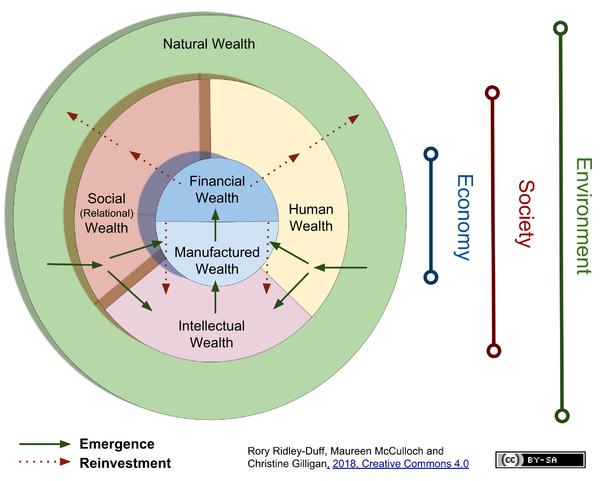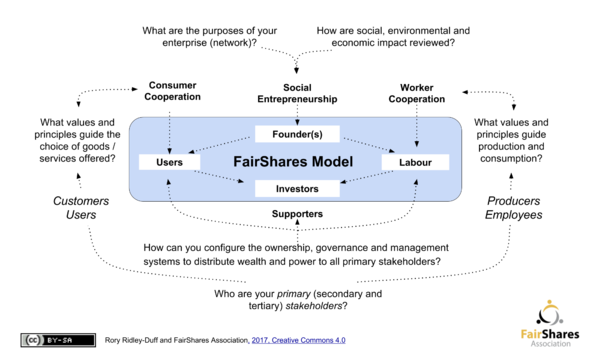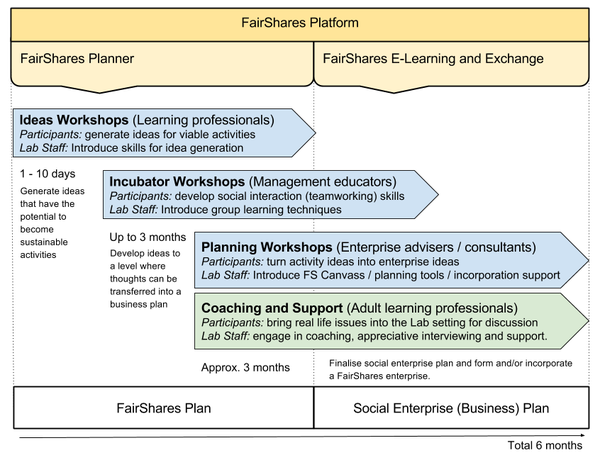FairShares Model
Contents
Introduction
The FairShares Model enables you to (re)design companies, cooperatives, associations and partnerships to fully recognise and reward enterprise founders, workforce members and users/customers who invest natural, human, social, intellectual, manufactured and financial wealth. We recognise that wealth is generated by stewarding nature to enhance human skills and capabilities, building relationships between people, enabling them to generate and share ideas that stimulate goods to meet human, societal and environmental needs.
By recognising and rewarding these six forms of wealth contribution, a more ethically grounded concept of wealth guides our human endeavours to create, distribute and reinvest forms of capital to meet a wide variety of needs.
FairShares Model V3.0 is implemented through:
- Five Values and Principles
- Six Key Questions
- Five Learning and Development Methods
- Four Legal Choices
- Seven ICT Platforms
- Six Forms of Wealth
This page introduces you to the concept of a FairShares Company and FairShares Co-operative. You can also set up a FairShares enterprise as a partnership or association.
To create the rules for a new enterprise, you can use the FairShares Rules Generator.
Imagine an organisation where the knowledge creation model of Wikipedia is combined with the governance model of the John Lewis Partnership and the values and principles of the Co-operative Group? This is the FairShares Model. It is an approach that contributes to a society in which every adult can become a member-owner of the organisation(s) for which they work, from which they regularly buy goods, and from which they receive social services. In short, it envisages a society in which every adult becomes a co-owner of the organisations on which they, their family and their community depend. FairShares companies and co-operatives can issue share capital and contribute directly to the elimination of poverty by paying dividends to their members based on their participation.
Most organisation structures are not designed with the goal of power and wealth sharing in mind: structures are fixed at incorporation and changed only if a situation demands it. Typically, one set of interests (i.e. founding entrepreneur(s), charitable/social objects, financial investors, consumers, workers) are given priority. A FairShares social enterprise puts in place a structure that changes over time and is designed to give a voice to the interests of different stakeholders as they become important for sustainability. By facilitating co-operative governance, the enterprise is in a better position to maximise its potential for power and wealth sharing, and improve community well-being.
An enterprise usually starts when one or more founder members - by design or by accident - comes up with an idea for a product or service. Founders act as entrepreneurs to establish if the idea is viable. If they consider it is, they will start to trade goods/services and build systems needed to support business operations. Growing enterprises depend in part on customers and institutional investors who provide the working capital and feedback for organisation development. Enterprises – both for-profit and non-profit – encounter social pressures to incorporate as they grow. The most popular forms of incorporation are the Company Limited by Shares (CLS) and Company Limited by Guarantee (CLG).
In the ‘private sector’, founding entrepreneurs normally acquire all share capital (ordinary shares) in a CLS, become the directors of the enterprise, and start to recruit employees to operationalize their idea. They only issue more share capital if there is a need to raise finance for further investment. In an unadapted CLS, employees are subordinated in law to the interests of shareholders and directors. They are not (usually) invited to become members of the Company, or contribute to decision-making outside their specialist area of expertise. If they are offered share capital at all, the rights attached to it are limited.
The intellectual property created by employees is acquired by the Company and controlled by executive managers/directors. Where a single person (or small group) becomes majority shareholder, they gain control of the intellectual property created by employees and the wealth it generates. In this way, the design of private companies widens the wealth gap between those who own/govern the enterprise and those who sell their labour to it and buy goods from it. This contributes to poverty even in the wealthiest western economies.
Voluntary Sector (Non-Profit) Norms – The Company Limited By Guarantee
A typical response to the social problems created by economies based on privatised wealth and power is to create a charity or ‘non-profit’ company using a Company Limited by Guarantee (CLG). This form of incorporation involves the specification of charitable or social objects that define the purpose(s) of the enterprise or its trading activities. Founders re-frame themselves as trustee-directors responsible for ensuring that resources acquired are used to pursue a social purpose.
CLGs do not issue share capital so trustee-directors give up personal rights to the wealth created by the enterprise. Their role (in law) is one of stewardship, ensuring that funds raised are used to further the charitable (or social) objectives defined in the Articles of Association. As in a CLS, they can employ staff to pursue their social goals. Employees are not (usually) members of a CLG and they are legally subordinate to the trustee-directors. Employees still give up the intellectual property they create: it is acquired by the Charitable or Non-Profit Enterprise. The Company is then entitled to derive wealth from it to pursue charitable or social objects.
Social Economy Norms – The Co-operative Society / Mutual Company
Is it necessary to choose between these two models? In the last 20 years, three bodies of knowledge and practice suggest it is not. Firstly, there has been a big increase in socially responsible use of corporate assets (CSR). Secondly, there has been a renaissance in the co-operative movement, a reminder that democratically controlled enterprises that do not reproduce a dichotomy between commerce and charity are sustainable, scalable and relevant. Importantly, the internet has reduced the costs associated with democratic governance, making co-operative and mutual enterprises much more viable. Lastly, there has been a growing number of enterprises identifying themselves as ‘social’, deploying business models and institutional arrangements that improve human well-being through their trading strategies and ownership structures. Fairtrade is a large scale international example of this.
The FairShares Model draws primarily on social economy traditions: it is based on the assumption that the exclusion of primary stakeholders (employees, producers, customers, service users) from company membership and share ownership is one of the principal causes of inequality and poverty in society. Creating non-shareholding companies enables the wealthier sections of society to address some of the symptoms of poverty and social exclusion, but it cannot address the root causes because it changes neither the ownership structure nor the governance processes that create and sustain it. Traditional models (both the ‘private company’ and the ‘non-profit’) continue to institutionalise a division between producers and consumers on the one hand, and entrepreneurs and (social) investors on the other. This division is a product of employees and customers (users) being unable to secure representation for their interests when decisions are made to spend the wealth created by their interactions. As wealth in a market economy is created by the interactions of workforce members and customers, their exclusion from governance and ownership makes no social or economic sense.
A FairShares Company (and FairShares Co-operative) addresses this issue by distributing financial and social capital to the stakeholders who are needed to sustain it. Spreading power and wealth as it accumulates inhibits the emergence of unaccountable elites. It contributes to a society in which wealth and power are fairly shared.
First, we devised a set of values and principles based on a definition of a social enterprise created in January 2012 by Social Enterprise International Ltd. We link these values and principles to key questions for enterprise incubation and development.
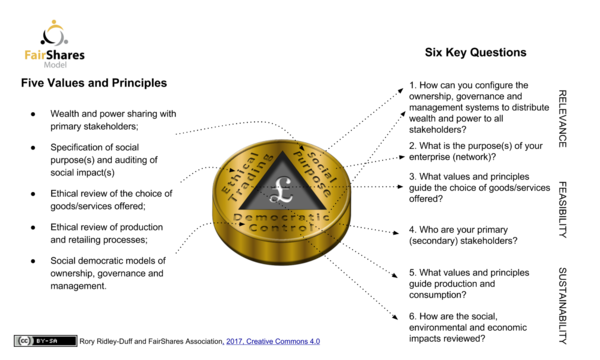 A model, process and method for FairShares
A model, process and method for FairShares
Second, we identify who is best able to answer each question to develop a design philosophy and governance model. Social auditing and diagnostic tools can help develop the architecture for the ongoing development of ownership, governance and management systems.
Lastly, to encourage the social systems to endure, we apply the design principles to model constitutions for companies, co-operatives, associations and partnerships. The model constitutions provide a kind of social DNA for the replication of the five principles by implementing them through new approaches to ownership, governance and management. We believe these systems will make it easier to achieve UN 2030 sustainable development goals.
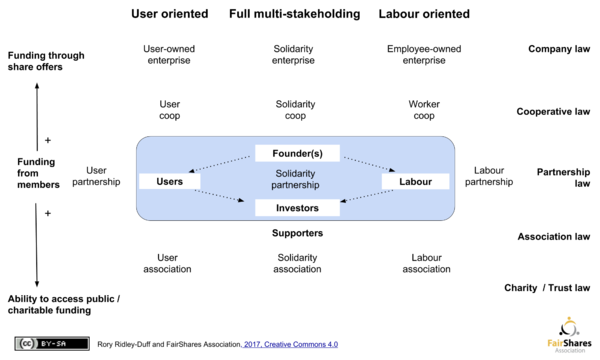 Legal Identities for FairShares
Legal Identities for FairShares
From 2019, you will be able to obtain support for developing your FairShares ideas by joining a local or virtual FairShares Lab. Each lab will provide workshops and support tools to help you consider the questions in a FairShares Canvass.
Through workshops, learning processes and with coaching and support, you will be able to design your multi-stakeholder co-operative enterprise by answering the questions in your FairShares Canvass.
The FairShares Model achieves power and wealth sharing by implementing the Co-operative Values and Principles of successful co-operative, mutual and social enterprises:
Governance processes recognise both individuals and interest groups, following (and extending) the 1st, 2nd and 3rd ICA co-operative principles of open membership, democratic member control and member economic participation.
Founders become members and have their participation rights in governance protected. Membership is then extended through Labour, User and Investor Shares to any natural or legal person who: a) continuously provides labour; b) continuously trades with the enterprise; and c) is willing to invest equity capital for a period of time.
As share capital is allocated to entrepreneurial, labour, trading and financial contributions, financial investment ceases to be the sole basis for company membership. Personal rights replace property rights as the rationale for membership, and group rights are balanced with individual rights to change power relations in governing bodies.
Knowledge production and sharing processes create an intellectual commons with IP belonging to its creator(s) and licenced to the Company or Co-operative by its members. This implements ICA principles 4 - 7: autonomy and independence; member and public education; co-operation amongst co-operators/co-operatives; concern for community.
The Creative Commons Licence that enables knowledge sharing on Wikipedia also underpins the FairShares approach to IP. Members' IP is licensed by its creators to the FairShares Enterprise that uses it under a Creative Commons Licence. This ensures IP can be used by the enterprise and its members, but does not involve a transfer of ownership from the creator(s) to the enterprise. This has the effect of creating an intellectual commons while preventing the alienation of producers from the IP they create. If a member leaves, the IP can be used by both creator(s) and the enterprise.
Return to the Main Page

